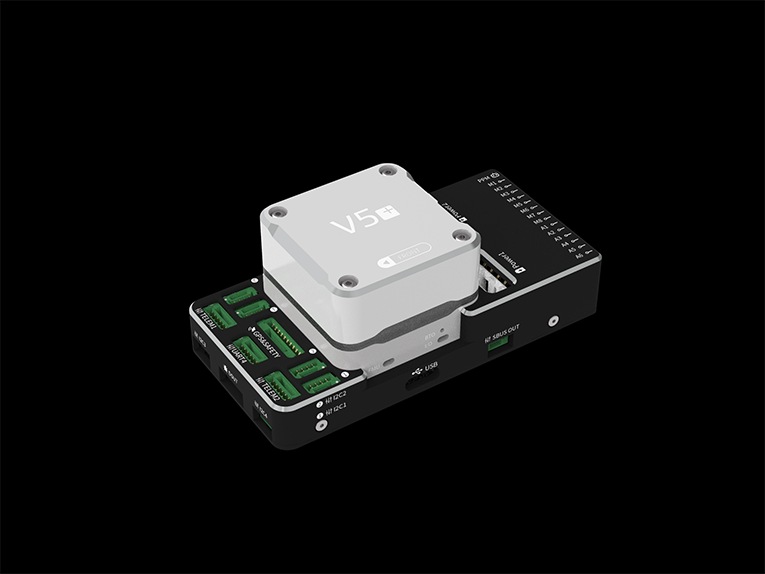CUAV V5+ Autopilot
V5+®is an advanced autopilot manufactured by CUAV®. It was designed by CUAV®in collaboration with the PX4 team.
The autopilot is recommended for commercial systems integration, but is also suitable for academic research and any other use.

Some of its main features include:
- Full compatibility with the Pixhawk project(opens new window) FMUv5 design standard and uses the Pixhawk Connector Standard(opens new window) for all external interfaces.
- More advanced processor, RAM and flash memory than FMU v3, along with more stable and reliable sensors.
- Firmware-compatible with PX4.
- Modular design allows users to customize their own carrier board.
- Built-in vibration dampening system with high performance shock absorption system.
- Multiple-redundant sensor and power systems for improved flight safety and stability.
[!Tip] V5+ Autopilot is an updated version of V5, if you use V5 Autopilot, please visit V5 Autopilot; Home also documents the difference between the two.
Main application scenarios:
It can be used as an UAS equipment development board hardware for scientific research and can also be written into PX4/arduPilot programs. It is applicable to and not limited to the following frameworks:
- Rover(including lawn mowers, agricultural sprayers, express delivery vehicles, etc.)
- Unmanned ships
- Unmanned submarines
- UAV/Drone (Various shapes and specifications of heilcopter, copter, plane, VTOL, etc.)
- Robots
Quick Summary
Main FMU Processor: STM32F765
- 32 Bit Arm® Cortex®-M7, 216MHz, 2MB memory, 512KB RAM
IO Processor: STM32F100
- 32 Bit Arm® Cortex®-M3, 24MHz, 8KB SRAM
- 32 Bit Arm® Cortex®-M3, 24MHz, 8KB SRAM
On-board sensors:
- Accelerometer/Gyroscope: ICM-20689
- Accelerometer/Gyroscope: BMI055
- Magnetometer: IST8310
- Barometer: MS5611*2
Interfaces:
- 4 I2C ports
- 1 SPI buses
- 2 CAN BUS
- 2 ADC
- 14 PWM outputs (6 from IO, 8 from FMU)
- 1 dedicated PPM IN
- 1 DSM/SBUS/RSSI
- 2 power with analog voltage and current monitors
- 1 GPS&Safety
- 2 TELEM With flow control
- 1 UART4
- 1 DSU7(Debug)
Power System:
- Power: 4.5~5.5V
- USB Input: 4.75~5.25V
Weight and Dimensions:
- Weight: 91g
- Dimensions: 85.5*42*33mm
Other Characteristics:
- Operating temperature: -20 ~ 80°c(Measured value)
Purchase
[!NOTE] Autopilot may be purchased with included Neo GPS module
Connections
Pinouts

[!TIP] DSU7 is the newly named interface of CUAV, which includes FMU SWD interface and UART7. When V5+ runs PX4 firmware, UART7 is used as DEBUG interface, and when V5 runs ArduPilot firmware, UART7 is used as universal serial port. POWER2 is the I2C smart battery interface by default. The RCIN interface is only limited to supply power to the remote control, and cannot be connected to any power source/load.
Voltage Ratings
V5+ AutoPilot supports redundant power supplies - up to three sources may be used:Power1,Power2andUSB. You must supply power to at least one of these sources, or the flight controller will be unpowered.
[!Comment] On FMUv5 based FMUs with PX4IO module (as is the case for the V5+), the Servo Power Rail is only monitored by the FMU. It is neither powered by, nor provides power to the FMU. However, the pins marked+are all common, and a BEC may be connected to any of the servo pin sets to power the servo power rail.
Normal Operation Maximum Ratings
Under these conditions all power sources will be used in this order to power the system:
Power1andPower2inputs (4.5V to 5.5V)USBinput(4.75V to 5.25V)
Over Current Protection
The V5+ has over current protection on the 5 Volt Peripheral and 5 Volt high power, which limits the current to 2.5A. The V5+ has short circuit protection.
[!Warning] Up to 2.5 A can be delivered to the connectors listed as pin 1 (although these are only rated at 1 A).
Building PX4 Firmware
make px4fmu-v5_default upload
Building ArduPilot Firmware
./waf configure --board CUAVv5Nano
./waf copter --upload